|
 
Introduction
VIA's KT333 chipset was recently covered in the online hardware press and lauded for it's support of the DDR333/PC2700 memory standard while still running AMD's Athlon or Duron Socket A processors at their rated bus speed of 133MHz. DDR333 memory, as you can probably guess, runs at a speed of 166MHz and the 333 is garnered from it's DDR nature, the D standing for double.
While VIA's own KT266A chipset has been able to run the memory at 166MHz on many boards, it does so at a cost. You are also forced to run the processor bus synchronous with the memory clock meaning some front side bus clocking of the processor and consequently the whole system. Since PCI and AGP bus speeds are tied to the CPU front side bus speed by means of a divider, raising the CPU bus speed means you pull PCI and AGP out of spec.
With the divider at 1/4 for correct operation at 133MHz CPU bus giving a PCI speed of 33MHz and AGP of 66MHz (AGP is fixed at 2x PCI), increasing the CPU bus to 166 gives a PCI speed of 41.66MHz and AGP of 83.33MHz. Both run quite far out of specification and while many graphics cards are happy at 83.33MHz AGP, PCI speed over 40 starts to cause problems for some devices with network cards and hard disks being the usual candidates for failure.
So KT333 brings with it the ability to run the memory asynchronously to the CPU bus and keep everything in specification at the 1/4 divider. We haven't been able to test for the presence of a 1/5 divider on the KT333 for correct PCI/AGP operation at 166MHz yet, but one Socket A AMD board has been able to do this for quite some time.
While focus on VIA's chipset rightfully draws attention with VIA being the main chipset supplier for AMD based systems, we shouldn't forget that another chipset has supported DDR333 memory for a while. It has ability to run the CPU and memory busses asynchronously for 133/166 CPU/Memory support but also has supported the 1/5 and indeed the 1/6 dividers for running the CPU bus at 166 and 200MHz. This keeps PCI and AGP in specification at those speeds and close to them at speeds above those markers. Above 133MHz CPU bus, the memory runs synchronous to the CPU bus.
This is actually more desirable than the KT333 asynchronous solution since DDR latency increases when it is run out of sync with the CPU bus. The chipset that VIA seem unable to match feature wise (we'll see about the 1/5 support on KT333 soon) is the ALi Magik 1.
The ability to run at 166/166 and keep PCI/AGP in spec is something that should catch the eye of any overclocker that has lost a hard drive to the evils of a high PCI bus on an AMD system. Intel seem to have got the right idea with support for a seperate PLL timing circuit on the i845-D chipset to run PCI/AGP in spec irrespective of any other bus speed, although this 'Fixed' mode isn't implemented on all boards.
ALi (Acer Labs Incorporated) have had an AMD chipset license for quite a while and the Magik 1 is the current pinnacle of their labours. It's this chipset that IWill have chosen to use on their flagship Socket A motherboard, the XP333-R.
So we've seen that the ALi Magik 1 chipset on the XP333-R is actually more capable at this point in time than the KT333 so lets take a look at what IWill have done with the rest of the board.
Specification
Processors
Supports Socket A for AMD Athlon XP, Athlon & Duron processors
Supports 266/ 200 MHz FSB
Supports AMD Athlon XP from 1400+ to 1900+ and higher
Supports AMD Athlon CPU from 700 MHz to 1.4 GHz and higher
Supports AMD Duron CPU from 600 MHz to 1.0 GHz and higher
Supports adjustable Vcore and VIO function
Chipset
ALi MAGiK 1 chipset (C version)
ALi M1647 (North Bridge)
ALi M1535D+ (South Bridge)
Bus Frequency
Supports DDR266/200 MHz FSB
MicroSteppingTM IWILL CPU frequency setting
Bye-Bye JumperTM IWILL Smart Setting
System Memory
Supports DDR memory
Supports DDR333/ 266/ 200 DDR module
Supports PC2700/ PC2100/ PC1600
Supports 184-pin Unbuffered DIMMs
Max. 3GB memory capacity
On-Board IDE RAID Controller
Integrated HighPoint HP372 IDE RAID chip (XP333-R)
Dual ATA133/100/66/33 IDE channel
Supports ATA133/100/66 drives
RAIDO/RAID1 level support
On Board IDE
Dual ATA133/100/66 IDE Channels
Supports ATAPI IDE CD-ROM, ZIP-100 & LS-120
Supports PIO Mode up to Mode 4
On Board Audio
C-Media 8738-MX 6 channel sound chip
Supports 6 Channel Speakers
32-voice HRTF-base 3D positional audio
Supports Microsoft DirectSound 3D and Aureal A3D
Supports SPDIF digital sound via IWILL SuperAudio (optional)
Power Management
Adjustable Vcore (16 Setting 1.3-1.85V by 0.05V)
Adjustable VIO (Normal, Increase 5% or Increase 10%)
VRM 8.4 support
As you can see, IWill haven't skimped on features to the same extent as Abit with their flagship board, the KR7A-RAID. Both share the same Highpoint HPT372 RAID controller that also doubles as a normal IDE controller with support for ATA133 devices. The ALi southbridge also supports the ATA133 transfer mode and drive specification, although since I have the luxury of SCSI for all my storage subsystems, I'm unable to report on them directly. The support is there however.
The IWill also adds a favourite of mine, a CMI 87xx series audio processor. In this case it's the 8738-MX with 6-channel support and if you buy a board with the SuperAudio add-on, you'll receive a backplane with RCA and Optical SP/DIF input and output. The SuperAudio backplane also features rear and centre/bass channel outputs which are also supplied for non-SuperAudio equipped boards. Make sure you are getting the right board when you purchase.
The other things notable on the official spec are of course PC2700 memory support and the explicit mention of adjustable Vcore and VIO (this seems to be confused with Vmem AND Vcore in the product literature, website and BIOS). The website mentions the VIO adjust in the BIOS but the BIOS says the feature adjusts Vcore. The manual also points you to the VIO jumpers on the board which seem to adjust the memory voltage. Quite confusing. It seems that the 'VIO' jumpers on the board adjust memory voltage and the Vcore 5%/10% adjust in the bios is for VIO.
Whatever the configuration, the board has been designed from the outset for the overclockers with IWill even consulting hardware websites on the features, specification and the resulting choice of the ALi Magik 1 chipset.
Layout and Installation

Starting as we always do at the top left of the board and working our way across and down we can see that the CPU socket, northbridge and fan and DDR DIMM slots are the dominant features on the top half of the board. IWill have been thoughtful enough to put some protective transparent tape underneath the socket lugs to prevent board damage when fixing or removing your cooling device. A nice touch and something we are beginning to see on more and more boards.
The CPU socket has plenty of room around it and I had no trouble installing the heatsink used for testing, the Swiftech MCX478 (I bought it as the Socket 478 version for Pentium 4 motherboards but it's perfectly usable in Socket 462 mode without the Socket 478 mounting brackets). The MCX is one of the larger sinks available at 80mm so any popular sink of sane dimensions will fit without issue.
6 capacitors flank the bottom left corner of the socket on this rev 2.1 board. There are a few versions of the IWill XP333 floating around with the 2.1 revision being the latest and supporting (or not as the case may be, keep reading!) the asynchronous CPU/mem bus option.
On the rev 2.1 board the ATX connector has been moved from the middle of the top edge to a vertical alignment next to the C-Media audio connectors on the ATX backplane. It's placed here, next to the power regulator chips, to supposedly fix the low 5V rail problems that afflicted some revision 1.0 boards. I'd have preferred it in the old position but you can't have everything!
The IDE and RAID connector ports are vertically aligned at the right edge of the board in the top half. This is the ideal placement for them as far as this reviewer is concerned so marks to IWill for that. The floppy connector is horizontally aligned in the bottom right sector of the board and while that's not a problem for me anymore since I don't use a floppy drive, it might be annoying for some.
As always on the bottom half of a board these days, everything is standard for the most part. From the AGP port down to the 5 PCI slots (33Mhz, 32-bit) and in the layout and positioning of the tiny C-Media controller and the HPT372 chip, everything is where you'd expect it on a Socket A board.
Installation was fine. The previous occupier of the case was a Pentium 4 board and with that removed, installation was a cinch. I installed the CPU and heatsink outside of the case since the sink uses mounting bolts on the motherboard. After that it was just a matter of screwing the board to the case mounts and installing memory modules (just the one in this case) and my add-in cards (graphics, audio, SCSI controller, NIC). The ATX power supply cable was plugged in (no peripheral PSU cables on AMD boards thank god) and the board was booted.
Bundle and Presentation
The presentation of the board was above average and it's nice to see companies making the effort on their boxed boards that are available from retailers. OEM supplied boards can be as bland as you like but the consumer enjoys a little extra. Anyone who remembers the original KT133A champion, the IWill KK266 (and variants) will recognise the distinctive packaging. The box comes with a CD shaped cutout in which you can see the installation CD and opening the box shows you the opaque plastic clamshell that holds the board and the extras.
The extras are fairly spartan with just the board, IDE and floppy cables, manual (paper and photocopied in the review sample) and the audio backplane and ribbon connector for it. Retail boards will also contain a driver disk for the RAID controller for use when setting up your operating system on a drive hooked up to the HPT372. Overall the presentation is excellent with the bundle contents a bit sparse although nothing significant was missing bar maybe a couple of extra USB ports.
Performance
For the overclockers among you, everything in the review prior to this point is irrelevant. The board could be oddly shaped and arrive in a brown paper bag bound with string as long as the performance was up to scratch.
A quick rundown of the test system before we have a discussion about the test results and then the results themselves.
- IWill XP333-R (revision 2.1) AMD Socket A DDR Motherboard
- Unlocked AMD Athlon XP1500+ Processor (1.33GHz, 10 x 133)
- 1 x 256Mb Samsung PC2700 DDR Memory Module (CAS2)
- Gainward Ti550 GeForce3 Ti500 64Mb
- Adaptec 39160 PCI SCSI Dual Channel U160 controller
- 2 x 73Gb Seagate Cheetah U160 10,000rpm SCSI disks
- Plextor 12/10/32S SCSI CDRW
- Pioneer 6x Slot-load SCSI DVD
- Creative Labs Soundblaster Audigy Player (SB0090 version)
- Windows XP Professional Build 2600.xpclient.010817-1148
- DetonatorXP 22.40 NVIDIA drivers
- Aquamark v2.3
- Quake3 v1.30
- POVRay v3.1g.msvc.unofficial-win32 dated 28 August 2001
- 3DMark 2001 Professional
- SiSoftware Sandra v2002.2.8.64
- Serious Sam: The Second Encounter Dema
A few things there that deviate from the norm in my Socket A DDR motherboard reviews. On the hardware side we have the unlocked XP1500+ processor. However, on the XP333-R choosing any other multiplier other than the default stopped the board from booting so the unlock made little difference.
Secondly I've moved to using a stick of high clocking Samsung PC2700 DDR memory. It's a 256MB single-sided module and clocks high.
On the software side we are using the latest Sandra build (comparable numbers to previous 2002 versions) and the addition of Serious Sam: The Second Encounter Demo to the benchmarking mix. It's easy to run the numbers on Serious Sam and it's a very pretty benchmark as well as being an excellent overall system test so we've added it.
As far as running the benchmarks on the board went and overclocking it, everything was fine bar one thing. Selecting the 133/166 Asynchronous mode in the BIOS to run the CPU bus at 133MHz and the memory bus at 166MHz (DDR333/PC2700) spec caused the memory controller to run the memory at 133MHz and the memory scores in Sandra were very poor, well below the reference numbers. A possible incompatibility with my PC2700 module perhaps. Quite possible since if you have read KT333 reviews from around the web, you'll have heard that the JEDEC standard for DDR333/PC2700 is yet to be ratified.
This means that any module claiming to be PC2700 or DDR333 isn't 'officially' supported since the standard doesn't officially exist yet. This may be the cause for our little hiccup since the BIOS may not know about the Samsung memory on the module. Either way, the asynchronous mode didn't work on this board/memory combination so I can't give you results. A shame since it's one of the selling points of the chipset and board.
The means that the results you will see are from 2 performance points. The first is 10 x 133 with memory at 133MHz CAS2 which is the CPU at defaults and the memory running at PC2100 spec. The second is 10 x 166 with memory at 166MHz CAS2. The CPU was happy to run at 1.66GHz to let us to run the memory at PC2700/DDR333 speeds. We can also see that the PCI and AGP busses are running in spec at 166MHz using the 1/5 divider (selectable in the BIOS).
So, first up we'll look at 3DMark 2001 performance. We'll switch to 3DMark 2001 SE in due course but since scores are comparable we'll use the older version in this review.
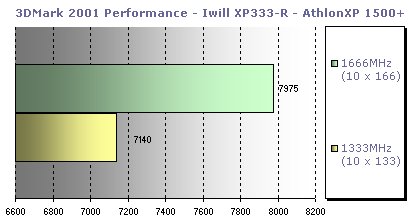
We break the 6000 minimum that we like pretty easily here, even on the comparatively slow XP1500 processor. By comparison, the KR7A-RAID using the same CPU and memory settings scores 7480 out of the box and the MSI nForce board scores 7450 using the same CPU. With everything else being equal, the XP333-R is the slowest of the three at 3DMark out of the box. The reason for this is the comparatively poor memory bandwidth performance from the ALi chipset. We'll see proof of that later. However it's not a bad score. Anything over 6000 without doing anything to the system indicates good performance.
The overclocked result at 166MHz FSB is poor given the potential throughput of the memory controller at that speed, however all is not well on the memory side of things on this board using the test memory module as we'll see next with the Sandra results.
We'll skip the CPU benchmarks in this review since they don't show anything of note other than the CPU working correctly. We'll use POVRay after this to show CPU operation. The memory benchmark from Sandra is very interesting however. Take a look at the following cropped selection from the Sandra Memory Bandwidth benchmark.

Here you can see that Sandra thinks the controller is being run at 165MHz. I triple checked that the front side bus and therefore memory controller was set to 166MHz and each time it was. WPCUID confirmed the FSB to be slightly less than 166MHz at 165.38MHz and that Sandra was just rounding down.
The following graph shows the results from the benchmark.
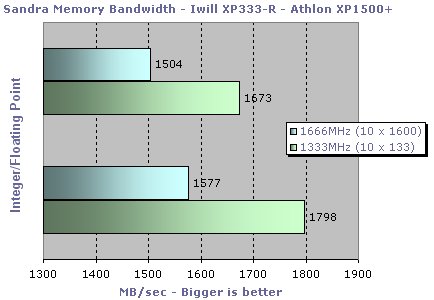
A double glance at the graph will show you what's wrong. I didn't get them back to front either! Performance at 133MHz memory clock was slightly under the Sandra reference numbers for the chipset and a fair bit less efficient than competing chipsets from VIA and Intel that both get near or exceed 2GB/sec in this test.
The performance at 166MHz front side bus and memory clock took a massive nose dive underneath even the 133MHz numbers and on this board and this memory module is entirely reproducable. I tried forcing CAS latencies and module performance in the BIOS using the available options but I couldn't improve on the 166MHz scores which should have been around 2400MB/sec.
An incompatibility with the Samsumg module I was using is most likely and something to look out for. Other websites reviewing this board and using Crucial modules (Micron chips) do much better and an OcUK forum member (hi Bigsy!) using Hynix chips on his modules on the same board gets expected scores.
The ALi chipset underperforms at the best of times compared to KT266A and i845-D but the 166MHz numbers weren't nice at all. If anyone has any other explanation other than module incompatibility then let me know and I can hopefully revisit the board using the same module. We have to report what we find.
A quick look at POVRay to make sure the CPU is working properly.
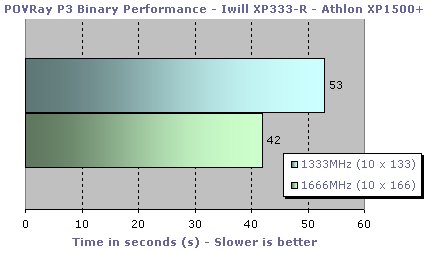
The results of 53 and 42 seconds are exactly what we were expecting and shows that the CPU runs unhindered on the board.
Onto the Quake3 results. Quake3 is our first OpenGL benchmark and in this configuration is more a test of CPU and memory performance rather than graphics card power so it's a valid inclusion. Here's the graph.
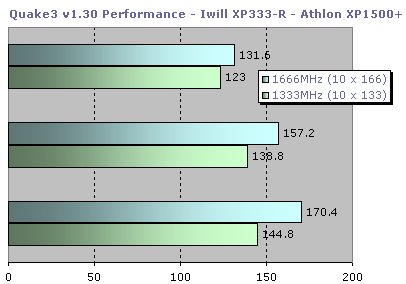
As we move down the graph from 1600x1200 at the top through 1280x1204 and 1024x768 at the bottom, you can see the effect that the overclocking has on the scores. At the lower resolutions where graphics card performance isn't the limiting factor, increasing our front side bus and memory clocks to 166MHz has a good effect with a near 18% increase from our 25% increase in bus clock.
As resolution gets bigger at the top of the graph, the graphics horsepower also has an effect and the increase in performance solely from the bus clock increase gets smaller, down to just under 7%. Increasing GPU and card memory clocks will do more for the scores here. Remember, at both speeds, due to the 1/5 divider at 166Mhz the PCI and AGP busses are running at identical clocks (33/66).
Next up we have Aquamark. The CPU speed increase to 1666MHz should give us a handy increase but the low memory performance will pull the score back. We shouldn't see much variance despite the apparent increase in system performance.

The graph is weighted to show off the increase but in reality it's less than 6%. The CPU speed can only haul the performance up so much before the low memory performance drags it back down. It's a shame since the hardware is there for a 50fps+ score but the memory controller and performance slows things right back down. Disappointing, especially since the KR7A-RAID does 50fps+ out of the box on the same CPU and graphics card.
The last benchmark we'll take a look at is the new boy, Serious Sam: The Second Encounter. I used the demo version so that you'll have something readily available to compare your system to. Like 3DMark, Serious Sam 2 is a nice full system test with some demos enjoying CPU clock, memory bandwidth or raw graphics performance.
In the test, we used the Valley of the Jaguar demo where the increase in CPU speed should show us a decent increase in the lower resolutions, just like Quake3. Here's the graph, again running from 1600x1200 to 1280x1024 to 1024x768.
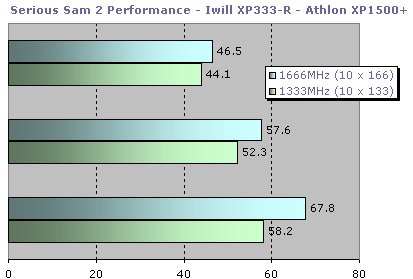
We used the Normal graphics preferences here and set the dem_bprofile variable to 1 (/dem_bprofile=1 at the console) so the game would generate the demo statistics for it. The demo take a fair amount of time and is also very pretty to look at while you run it. Sound is on during the benchmark.
As we expected, the lower resolutions are helped more by the increase in bus clocks and as the graphics card is made to work harder as the resolution increases the performance increase gets smaller (16.5% to 5.4%).
Overall performance was very good from the board but since it's a debut benchmark for us we don't have anything to compare it to on similar platforms (GeForce4 on P4 and i845 DDR is too wide of the mark!). Even at 1600x1200 performance looked fine. It would have been even better had the memory performance been at a decent level. Again the CPU has to work hard to scrape any increase at all at high resolution since the memory bandwidth reduction doesn't help.
Performance Conclusion
Overall performance was good but slightly underwhelming, especially when overclocked since the memory controller didn't seem to like our test module at all. Performance at 166MHz being lower than 133MHz is something for the IWill guys to look at since I couldn't make the board perform when overclocked.
For your information, the board took the test CPU into Windows all the way up to 1.8GHz at 1.85V Vcore but stability was practically non-existant. For the CPU frequency, you need more Vcore and excellent cooling. RC5 would run 24/7 at up to around 1740MHz at 1.85V. The voltage mod on the board is simple too. Something for the enthusiast to investigate.
Given the strong FPU performance of the Athlon XP processor, performance was still good despite the problems. A weaker processor wouldn't have been able to save the XP333-R I fear but it at least it seems fixable with a different memory module perhaps so don't write the board off.
Overall Conclusion
Overall the board was excellent to test from my point of view since 1/5 and 1/6 dividers on AMD hardware at high FSB are something of a novelty unless you are running this board. Being able to run your PCI and AGP busses in spec is very welcome so top marks to IWill for the chipset choice to make this happen and marks to ALi too for providing the hardware.
The layout was fine with no niggles and the presentation was above average. I'm a fan of the presentation on IWill boards and it's certainly refreshing to see. If you don't upgrade very often or have the chance to test hardware you might not appreciate the little things but they are certainly welcome.
Performance was under par compared to the KR7A and also the nForce but this is down to the substandard memory performance of the chipset at 133MHz and the problems at 166MHz. It certainly wasn't bad performance, just not the huge performance some might lead you to believe.
The features are strong with the HPT372 being a good choice due its ability to run as a normal IDE controller. The CMI audio I'm a big fan of and marks to IWill for actually providing the support for the rear and centre channels that so many others forget to include.
Not quite the performance leader in Socket A solutions but the 1/5 and 1/6 dividers will appeal to many an overclocker since it's still the only board out there that can run 200 front side bus and keep PCI and AGP in spec. It really needs the massive FSB to claw back the performance disadvantage it has in the slow memory controller. Good job it can do that OK!
The problems running in asynchronous mode we'll put down to the same incompatibility that we saw at 166/166.
Overall I liked the board a lot and the features help numb the disappointing performance from the memory controller.
Price and availability wise, Overclockers.co.uk are carrying the RAID version for a super cheap £105 inc VAT. Add on their slightly high shipping charge and you'll get change from £115 which isn't bad for what you get.
Pro's
1/5 and 1/6 dividers at 166MHz and 200MHz Front Side Bus
Use of HPT372 and CMI 8738-MX on board audio
Price
Memory voltage adjust to 2.8V
Con's
Slow memory controller
Problems running at 166MHz with the Samsung PC2700 test module
Unable to use other multipliers on our unlocked CPU
A very nice board provided you feed it a compatible high speed memory module but not quite as quick as a KR7A. It needs huge FSB and a good job it's happy doing so.
|